Getting Started with NVIDIA CuOpt
NVIDIA announced its GPU accelerated PDLP implementation last year. The announcement included benchmarking results for a set of problems from MIPLIB benchmark library and claimed to be faster than the state-of-the-art CPU-based LP solver in 60% of the problems.
However, this new method comes with challenges. The initial announcement mentioned convergence issues and lower accuracy in some of the problems. Other sources, such as the HiGHS Newsletter and the FICO Blog, have echoed similar concerns.
What’s more exciting about CuOpt is their commitment to open source. Since the announcement, CuOpt has been open-sourced and added to the COIN-OR repository, which also maintains a mirror.
In this blog post, I will give a simple guide to get started with CuOpt and share my first impressions.
Finding a GPU
You guessed it, you need an NVIDIA GPU with CUDA support.
I use a Linode GPU instance with RTX4000 Ada GPU (I work at Akamai), which costs $0.52/hour. I also use Linode Images to save money when the GPU is not in use. Linode Images allow you to delete and recreate the same instance without losing the NVIDIA drivers or disk data.
Installation
Installing CuOpt is pretty simple. However, this was my first time dealing with CUDA, so I had to search around a bit to get the right drivers installed. I prepared a small Github repository to share 3 scripts you can simply copy&paste to get your machine working with necessary drivers and CuOpt installed: kutlay/getting-started-with-cuopt These scripts are tested on an Ubuntu 24.04 Linode GPU instance. Installation takes about ~15 minutes.
First try
I wanted to see the utilization of the GPU & CPU so I downloaded a good sized problem from the MIPLIB benchmark set: trimtip1. The problem has ~30k variables and ~15k constraints.
I used the CuOpt CLI to solve the model: cuopt_cli triptim1.mps --mip-absolute-gap 0.05 --time-limit 100
The GPU was under 100% load for the full duration of the solve:
 (Screenshot from
(Screenshot from nvidia-smi under load)
Whereas the CPU was only using 2-cores out of 16 I had:
 (Screenshot from
(Screenshot from top under load, interesting VIRT number there)
Doubling the GPUs
Over the past decade, CPU clock speeds have plateaued (generally staying under ~5 GHz), mainly due to power and thermal limits. This limits the improvements in mathematical solvers over the years, since most of the improvements are achieved by advancements in heuristics. PDLP changed this by making use of parallelism to a much greater degree. The rapid growth of AI has shown how powerful parallelism can be, especially when scaling across GPU clusters. GPU-accelerated solvers are exciting because performance can now improve year over year due to hardware advancements, allowing models to scale faster over time.
I’ve been looking for some evidence whether CuOpt scales well with simply using more (or faster) GPUs. One piece of evidence I found is from Mittelmann LP benchmark results on June 22nd, 2025 which tested six very large LP problems on two different GPUs and reported the time to solve each problem (in seconds).
RTX A6000 H100
---------------------------------------------
problem cuPDLP cuOpt cuPDLP cuOpt
=====================================================================
heat_250_10_500_200 13898 18904 7288 4611
heat_250_10_500_300 10184 11323 3696 4384
heat_250_10_500_400 5420 5124 3014 3233
mcf_2500_100_500 4859 14855 1166 1381
mcf_5000_50_500 5797 8403 2260 10134
mcf_5000_100_250 19584 8657 1461 2139
=====================================================================
dimensions constraints variables nonzeros
heat* 15625000 31628008 125000000
mcf_2500_100_500 1512600 126250100 253750100
mcf_5000_100_250 1775100 127500100 257500100
mcf_5000_50_500 2775050 126250050 253750050
These cards seem hard to compare but in various different benchmarks (1, 2, 3) H100 performs at least 2x better than RTX A6000. Price wise, H100 was roughly 5 times more expensive than RTX A6000. Keeping these in mind, the benchmark results from Mittelmann seem promising as H100 was between 2x and 6x faster than RTX A6000 (except for one of the problems).
The problems chosen for the above benchmarks are very large and may not apply to a lot of fields where mathematical solvers are used. It is hard to say what types of problems would benefit how much from a larger GPU. I encourage everyone to try CuOpt with different cards and observe how the scaling works for their problem.
Conclusion
GPUs are changing the way we solve problems. Many problem domains have already benefited from GPU acceleration, and now it’s time for mathematical solvers to benefit as well. I appreciate NVIDIA’s strategy to open-source CuOpt and advance the field with a strong product. I also expect commercial solvers will aim to surpass CuOpt, ultimately providing users with even more powerful tools in the future.